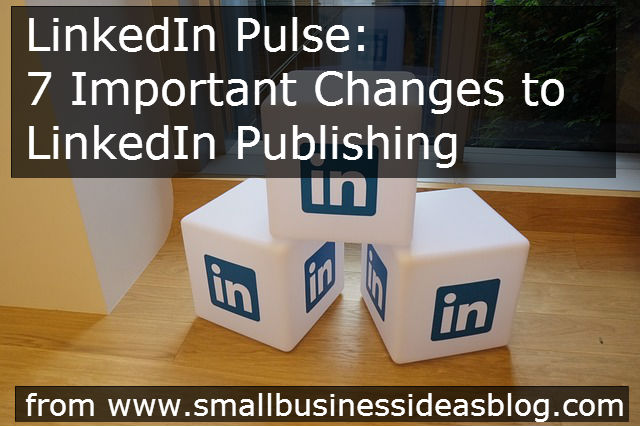 Last year, I published a study on how top LinkedIn publishers are getting featured on the Pulse. It is one of the most popular posts on my blog with over 3,000 social shares.
Last year, I published a study on how top LinkedIn publishers are getting featured on the Pulse. It is one of the most popular posts on my blog with over 3,000 social shares.
Soon after, I started publishing my own articles on LinkedIn. I managed to get one out of three posts featured in a content channel, resulting in hundreds of new followers and even subscribers to my blog.
I took a break for awhile because I was busy with other things, but I’m planning on continuing soon.
Publishing on LinkedIn can be a great way to create awareness for your business or personal brand.
But I noticed some important changes to the platform that you may want to be aware of and also wanted to share a few lessons learned from publishing on LinkedIn.
1. Content Channels are Structured Differently than Before
When LinkedIn opened up the Pulse for early access, their content channels were set up more like LinkedIn groups.
With LinkedIn groups, when discussions get viewed more, then naturally float to the top.
Therefore, discussions that are popular can get way more views than other discussions that are underneath them.
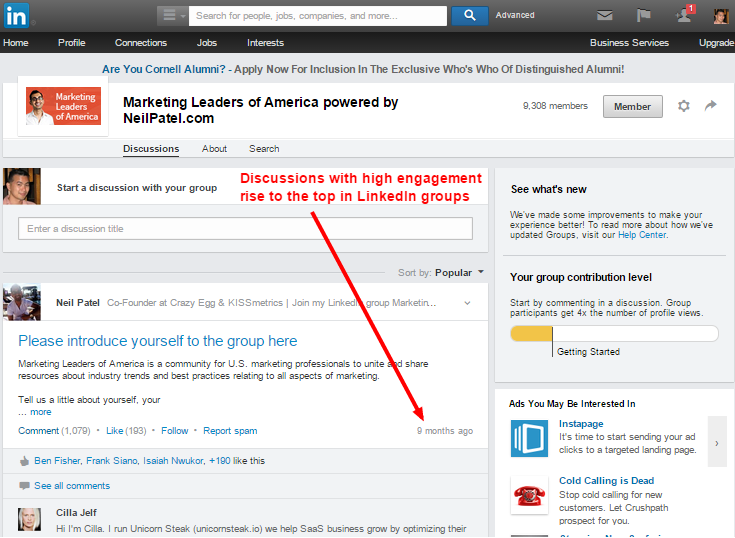
However, the articles in the content channels are now structured so that 10 or so articles show up on the left sidebar.
This makes it easier for readers to see all the articles and click on the one they want to read.
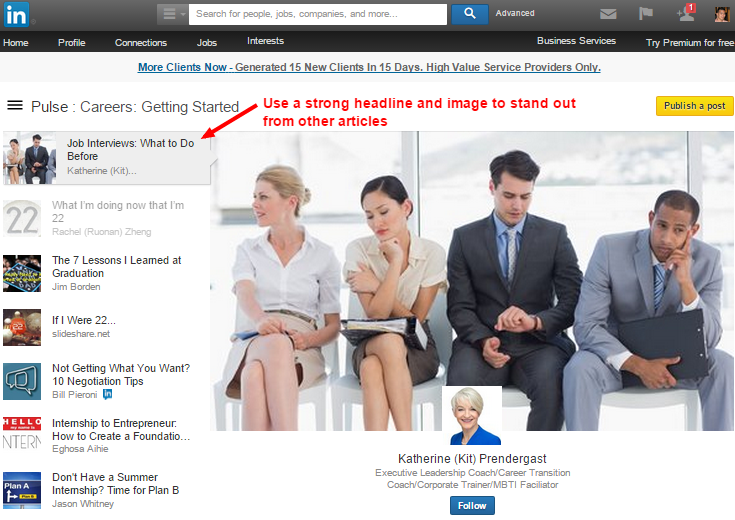
What this means is that having a strong headline and image are now more important than ever.
Before, lots of discussion and likes on your article could keep it popular for a longer period of time and send it a lot more traffic. Due to the structural changes, getting traffic is a bit more difficult now.
2. Editors seem to be Quicker at Finding and Promoting Content to Channels
It seems like LinkedIn’s editorial team has gotten better at finding and promoting content to their content channels.
Last year, I had some pretty good pieces before that never got featured in a content channel.
I discovered that you can tweet your article to LinkedIn’s editorial team if you published something amazing that hasn’t gotten featured.
Here’s how you do it.
Tweet to “Tip @LinkedInPulse” with a reason why your article is awesome.
For example, the format would be similar to the following:
“Here’s my take on why college is overrated (link to your article) Tip @LinkedInPulse”
Here’s an actual example of a tweet that I sent that got one of my articles featured.

You can read the full discussion in this thread in LinkedIn’s official Writing for LinkedIn group.
I’ve found that I don’t have to use this approach as much. If I wait a couple of hours, LinkedIn’s editors will usually find my post and add it to the right content channel.
I suspect that if you consistently write great content that is targeted towards LinkedIn’s audience, their editorial team will notice and perhaps keep an eye out for your articles. Brand new writers might still need to tweet to LinkedIn’s editorial team to get noticed.
3. Featured Images are Encouraged
When I first started writing on LinkedIn, a significant number of people weren’t using images in their posts. The first image that you added within the post became the featured image.
LinkedIn has now created a separate header image section with best dimensions specified.
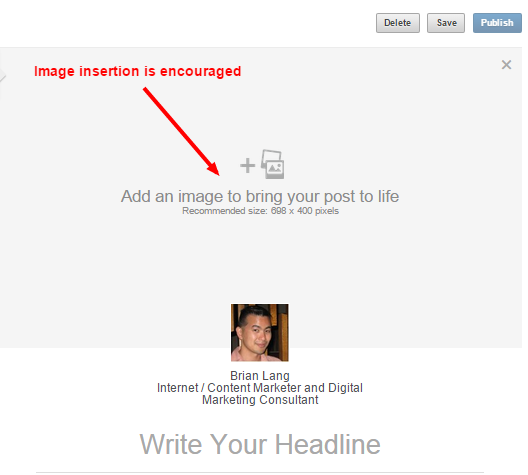
So now almost everyone has a featured image on their post.
Most people are still using generic stock photos though, so you can still stand out by using an eye catching image.
4. LinkedIn Now Has Post Analytics
One great feature of LinkedIn blogging is the post analytics. For each article, you can see where your traffic is coming from and your post views and activity over time.
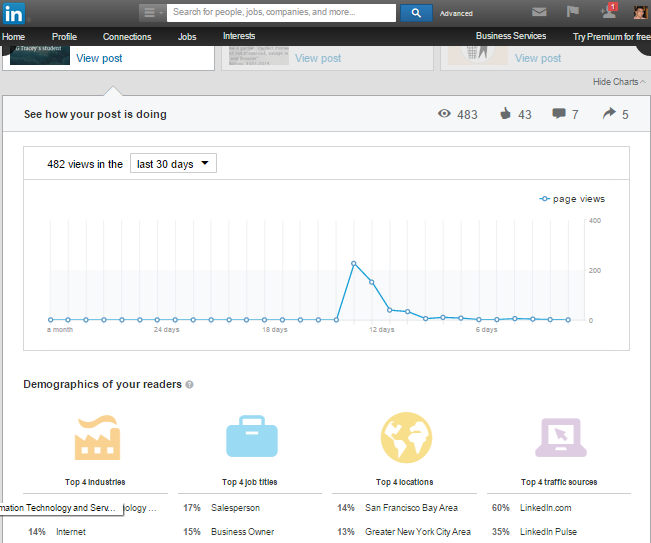
At one point, I thought about syndicating my own blog content onto LinkedIn. The reason I considered adding the same content to my own site was to get more SEO traffic.
However, with LinkedIn’s post analytics, I can see if an article is getting any search engine traffic to begin with.
An article on my site is more likely to get search engine traffic than on LinkedIn due to the SEO set up (LinkedIn doesn’t link directly to Pulse articles from other pages on LinkedIn).
Nevertheless, the analytics still give me a good idea about the SEO potential of an article. If it doesn’t get search traffic on LinkedIn, then it might not be worth adding to my own site.
To check and see if you have access to LinkedIn post analytics, visit this page:
https://www.linkedin.com/pulse/author/analytics
You can also go to your articles and click on the “View Stats” button:
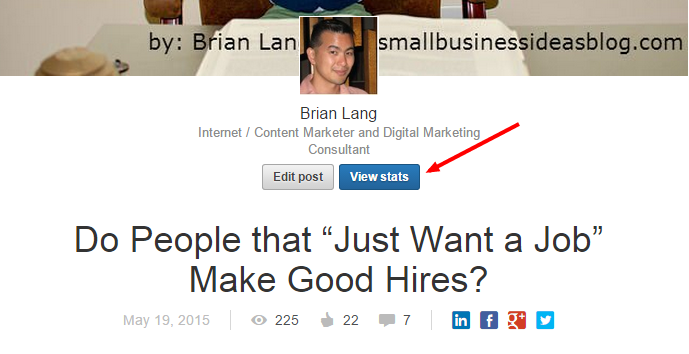
You can read more details about this feature on the LinkedIn blog:
http://blog.linkedin.com/2015/05/07/new-analytics-for-publishing-on-linkedin/
5. You Can Add Tags to Your Article
You can now add tags to your article to help other people find it. These tags are pre-defined by LinkedIn.
Just start typing in the tag field and it will suggest tags that you can pick for your article.
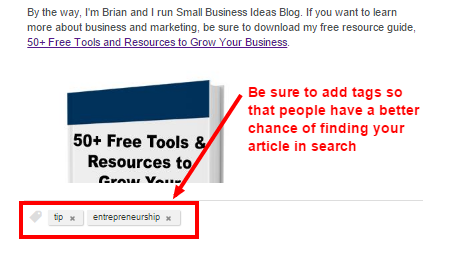
Adding tags helps people find your content on LinkedIn search, which means that your article might still get traffic long after it is published.
6. You Can Search for Content on LinkedIn Pulse
LinkedIn has a search feature that you can use to find content on LinkedIn.
To access this feature, click on the left of the header search and select “Posts” from the drop down menu or go to this page.
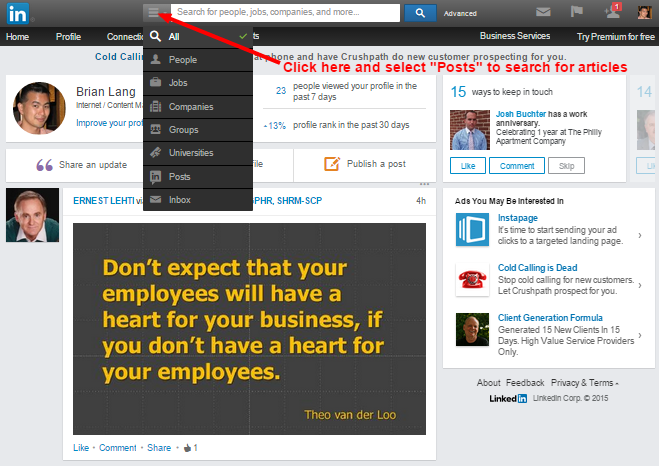
I’m not certain how frequently this feature is used, but it could allow more people to find your blog post well after it is published. So be sure you are using keywords in your articles and adding tags.
7. Getting Featured is Now Required to Appear on the Pulse
I recently submitted a guest post to Matthew Woodward about how I was able to get hundreds of new subscribers and followers from publishing on LinkedIn and it inspired him to give it a try.
He submitted his own article and ended up getting over 2,000 views on it in 24 hours and ultimately got over 300 subscribers from his first post. Pretty good for a first attempt!
However, the article was not featured on a content channel so it didn’t show up on the main Pulse feed.
In the past, posting an article that got a lot of views would allow that article to show on the main Pulse page, even if an editor didn’t feature it in a content channel. Unfortunately, this setup led to a few problems, including plagiarized articles showing up on the Pulse as well as low quality articles with “click bait” headlines.
I suspect that Matt’s article didn’t get featured because it was about SEO and LinkedIn doesn’t have a content channel for SEO at this time.
But don’t let that discourage you from writing a great article on a topic that you’re knowledgeable about. LinkedIn’s algorithm will still show the article to your connections and other people.
Even though Matt’s article didn’t get featured, it still got over 2000 views and netted him over 300 new subscribers, so I’d say that’s still a nice win.
8. LinkedIn Publishing Seems More Competitive Now
Due to the change mentioned in the previous item, LinkedIn’s editorial team also seems to be featuring more articles in content channels. High quality articles now have a better chance to make it to the Pulse if people engage with the article, although the down side is more competition.
When I first started writing on LinkedIn, the platform was only open to a limited number of publishers. You had to apply for early access and a lot of people were having trouble getting accepted.
Early in 2015, LinkedIn opened up its platform to its members in all English speaking countries and it plans to open up publishing to people in other countries in the future.
While more of my articles are getting featured in a content channel, on average they seem to be getting less views than before. This could be due to more articles getting featured.
Don’t get too discouraged though. I still see first time writers getting thousands of views on their first article.
Getting featured on a content channel is no longer enough. Nailing the headline is more important than ever if you want to stand out.
9. Focus on Topics You Are Strong In
In my previous LinkedIn study, I indicated that careers, business and self improvement are the topics that generally are most likely to show up on the main Pulse page and get the most views.
However, those topics are also the most competitive. I also mentioned that LinkedIn has other content channels that you can get featured on to get in front of a more targeted audience.
I’ve found that the articles I’ve written about digital marketing and social media have performed pretty well. Since that’s one of the topics I’ve been able to write about authoritatively, it’s easier for me to stand out against other writers on LinkedIn.
It’s not that I can’t write good articles about business and careers, but it’s easier for me to stand out when I write about digital marketing compared to other writers on LinkedIn.
So if you are writing on LinkedIn, you may actually do better if you choose topics that you are knowledgeable in AND can stand out in rather than popular topics like careers.
So with all the changes in the Pulse, is it still a good venue for lead generation?
The answer is yes, but as is the case with any multi-author blog, you’ll get considerably more leverage if you can stand out from the crowd. And now that the Pulse is open to anyone in English speaking countries, standing out is more important than ever.
If you want to learn more about publishing on LinkedIn, then be sure to download a free copy of my study on how top publishers are getting featured on the Pulse by clicking below. Some details include average post length, how to stand out and other frequently asked questions.
http://www.smallbusinessideasblog.com/sp/linkedin-publishing-study

thanks for sharing this usefull article